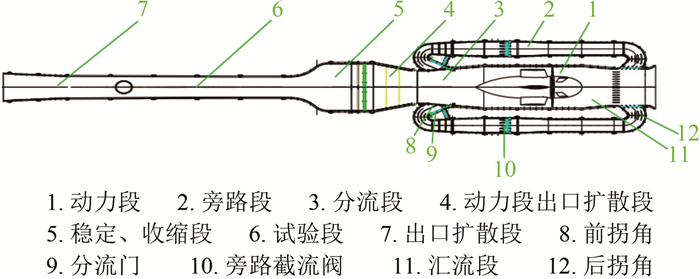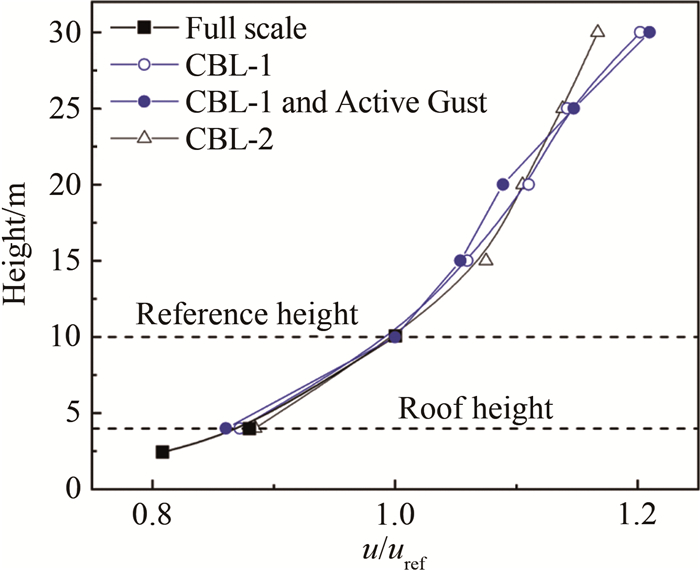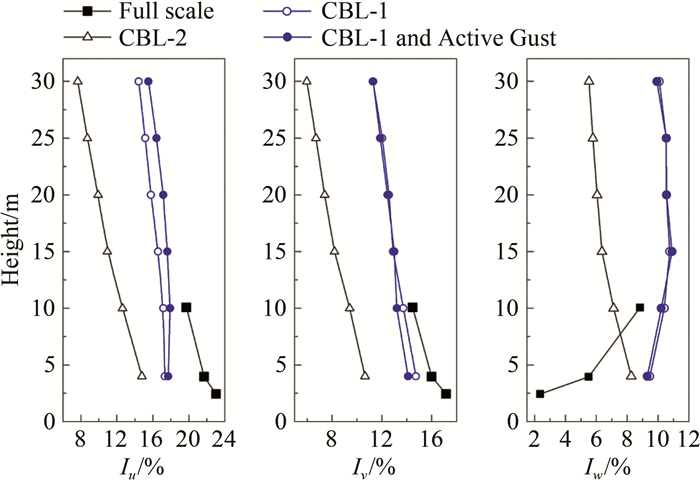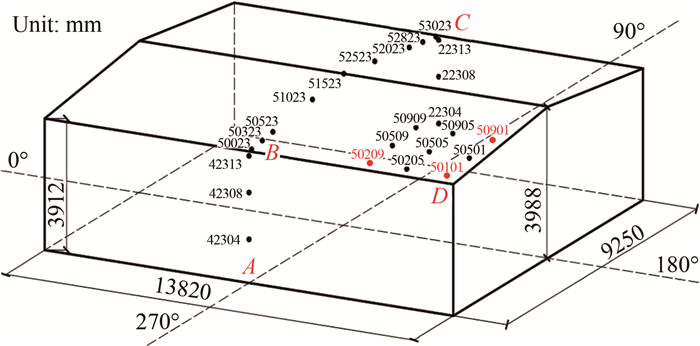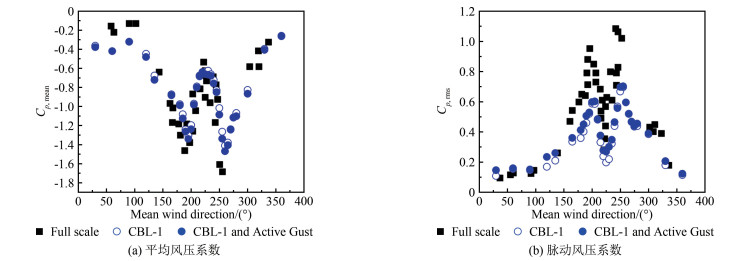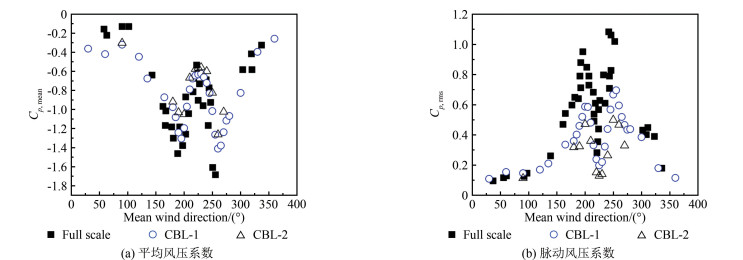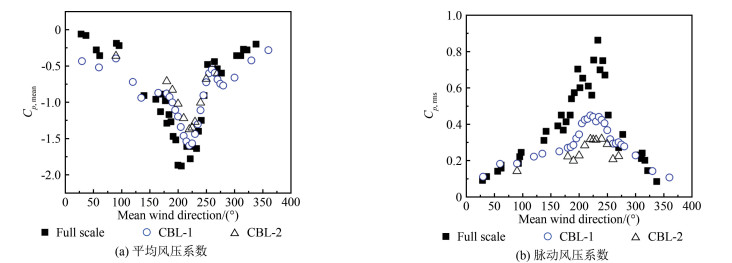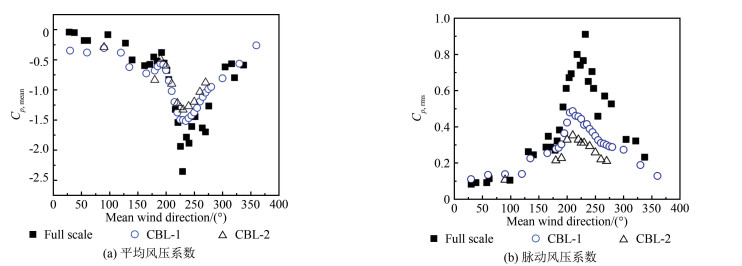Active turbulence simulation study of wind loads on standard low-rise building
-
摘要: 采用主动与被动湍流相结合的方法,在阵风风洞中模拟了不同湍流强度和湍流积分尺度的流场,开展了1:50低矮建筑标准模型测压试验研究。针对气流分离再附流动作用下的屋面中轴线区域和锥形涡作用下的屋面角部边缘区域,着重分析了不同来流湍流强度和顺风向湍流积分尺度影响下的风压变化规律。研究结果表明:湍流强度对气流分离作用下的迎风屋面屋檐区域以及锥形涡作用下的屋面角部边缘区域的平均风压系数、脉动风压系数和峰值负压系数均有显著影响;而湍流积分尺度对这些区域的平均风压系数影响甚微,脉动风压系数和峰值负压系数(绝对值)随湍流积分尺度的增大而有所增大。Abstract: This paper presents model scale tests for 1:50 geometrical scale laboratory modeling for the Texas Tech University (TTU) test building in a gust wind tunnel. This tunnel is able to add low frequency turbulence components for generation of large-scale turbulent flows by the conventional passive simulation technique or a technique combining active and passive turbulence generation devices. This paper mainly studies the effects of the turbulence integral length scale and turbulence intensity on wind-induced pressures on the flat roof of TTU full scale building. The results imply that the turbulence intensity has significant influence on the mean wind pressure coefficients at the leading edge of the flat roof under the separation bubble and in the corner zone for the conical vortex flow regime. Meanwhile, the turbulence intensity plays a predominant role in producing the fluctuation and peak pressure at the leading edge or in the corner area. On the other hand, the turbulence integral length scale has no noticeable influence on the mean wind pressure coefficients at the leading edge or in the corner zone. However, the turbulence integral scale length plays a slightly significant role in producing the fluctuation and peak pressure at the leading edge or in the corner zone.
-
0 引言
敏感性分析是一种研究模型中参数的小量变化对其他指标影响程度的分析方法。通过敏感性分析可以定量得到参数的敏感性导数,从而用于评估各参数的重要程度以及计算不确定度。该方法在武器装备性能评估[1-2]、工程结构设计[3-4]、石油开采[5]和气动外形优化[6-7]等方面应用较为广泛。
罗鹏程等[8]指出武器装备敏感性分析可用于评估武器装备的重要程度,是确定武器装备发展建设重点的依据。金镭等[9]通过敏感性分析获得了战斗机性能指标与国外先进飞机之间的差距,为战斗机的改型优化指明了方向。唐冕等[10]针对大跨度自锚式悬索桥结构,建立了基于桥梁多振型耦合的气动参数敏感性分析理论和方法。西北工业大学的徐林程等[11-12]采用自动微分方法获得了翼型压力系数对迎角、马赫数、雷诺数和几何外形的敏感性导数,其中,马赫数的敏感性导数明显高于其他参数。Albring等[13]利用开源代码SU2计算了M6机翼的阻力系数敏感度分布,计算结果显示激波附近区域对阻力的贡献最大。Yang等[14]基于翼型的敏感度信息和梯度算法对NACA0012翼型进行了优化,使阻力降低83%。Liu等[15]采用随机配置法对高超声速飞行器进气道流场计算结果进行了分析,得到了迎角、马赫数、雷诺数、来流温度和壁面温度等参数对压力场的不确定度和敏感度的影响,为进气道性能评估提供了可靠的数据支撑。
尽管数值计算在稳态流动的敏感性分析方面取得了巨大的进步,但是对于非定常流动,数值计算仍面临计算量难以承受、收敛性差等问题。因此,发展基于风洞试验的非定常流动敏感性分析方法显得尤为重要。
空腔流动是一种典型的大分离非定常流动,开展空腔流动的敏感性分析试验对内埋武器舱气动噪声载荷的不确定度评估具有重要的应用价值。近年来,人们在空腔流动参数影响研究方面开展了大量的工作。Plentovich等[16]通过在平板上粘贴金刚砂来改变空腔入口湍流边界层厚度,分析了边界层厚度变化对空腔流动特性的影响。Thangamani等[17]通过改变模型尺寸研究了雷诺数对空腔噪声的影响。Merrick[18]开展了马赫数为1.43、1.84和2.22的超声速空腔流动风洞试验,分析了马赫数对峰值噪声频率的影响。这些研究工作主要通过离散地改变试验参数(试验参数的相对变化量大于10%)来研究空腔流动参数影响,尚未发展出可连续改变试验参数(试验参数的相对变化量在1%左右)的敏感性试验方法。
本文综合采用调节调压阀的开度和变模型迎角的方法实现了亚、跨、超声速下马赫数的连续变化。开展了0.6、0.9和2.0等3个典型马赫数下的空腔噪声敏感性分析,计算了脉动压力系数、主导声模态St和谱峰对马赫数的敏感性导数。敏感度研究结果不仅可用于内埋武器舱气动噪声载荷的不确定度评估,也有助于更好地认识空腔噪声特性。
1 试验方法
1.1 风洞设备
试验在中国空气动力研究与发展中心FL-32直流暂冲式跨超声速风洞中完成。该风洞马赫数范围为0.3~4.0,雷诺数范围为(3.3~89.0)×106 m-1,试验段截面为0.6 m×0.6 m的矩形。超声速下,试验段四周均为实壁;亚跨声速下,将试验段上下壁板更换为槽壁。
1.2 空腔试验模型
试验模型采用中国空气动力研究与发展中心设计的C201标准空腔模型[19-20],如图 1所示。该模型由平板、腔体和盖板三部分组成。空腔模型前缘为可更换的安装块,在亚跨声速条件下采用椭圆形前缘以消除前缘流动分离,在超声速条件下采用尖劈外形以避免形成头部激波,从而有效避免了前缘分离和脱体激波等对下游空腔流动的干扰。试验过程中,模型通过支杆与试验段迎角机构连接,可实现迎角的连续变化。
C201空腔模型总长514 mm,宽320 mm。腔体长度、深度和宽度分别为200.0、33.3和66.7 mm。空腔几何长深比为6,属于典型的开式空腔流动。为了获取腔内噪声特性,在空腔底部中轴线上等距离布置了10个脉动压力传感器,如图 2所示。传感器型号为Kulite公司生产的XCE-062压阻式传感器,其量程为30 psi,传感器采样频率为50 kHz。试验过程中,采样持续时间设为10 s。
亚跨超声速下,利用总压耙(见图 3)测量空腔入口马赫数。总压耙是一种用于测量湍流边界层内速度分布的试验装置,安装在空腔上游5 mm处。总压耙的高度为19.8 mm,共17个总压测孔,测压管外径为0.6 mm,内径为0.3 mm, 为了降低激波干扰,孔与孔之间间隔一个孔的距离。静压测点布置在平板上,用于测量边界层静压。静压测点的流向位置与总压耙相同,展向距离总压耙约5 mm,以减小总压耙对边界层内静压分布的干扰。
1.3 马赫数敏感性试验方法
亚跨声速下,FL-32风洞采用收缩喷管,可通过调节上游调压阀的开度,连续改变试验段入口总压和马赫数。超声速下,FL-32风洞采用收缩-扩张喷管,试验段入口马赫数完全由喷管型面确定。喷管型面的调试需要花费大量的人力物力,且维护使用成本高,因此超声速风洞可供使用的喷管数量十分有限,通过更换喷管难以做到马赫数的连续变化。本文从C201空腔模型的特点出发,提出了一种通过改变模型迎角实现空腔入口马赫数连续变化的方法。试验中通过调节模型迎角,在平板前缘形成不同扩张(或压缩)角的膨胀(或弱压缩)波,气流经过平板前缘的膨胀(或弱压缩)波后,马赫数将升高(或降低)。
由于马赫数测量装置会对空腔流动产生干扰,因此马赫数测量试验和脉动压力测量试验分开进行。亚跨声速下,采用连续变马赫数的吹风方式开展试验,马赫数名义增量为0.010。超声速下,通过连续变迎角的方式改变马赫数,迎角增量为1°。
2 数据处理方法
2.1 马赫数计算方法
根据亚声速的等熵关系式和超声速的激波关系式,求解式(1)的非线性方程,可计算得到总压耙第i测点处的马赫数Mai。

(1) 式中,pi为总压耙第i测点处的总压,ps为边界层静压。
前期边界层测量试验结果[20]表明,不同马赫数下入口边界层厚度一般在5 mm以内,第6测点以上的测压管处于自由来流均匀区域。本次试验选择远离物面10个测点的平均值作为空腔入口马赫数Ma。

(2) 2.2 噪声数据处理方法
首先,滤除压力时序数据p(n)中的平均成分p,得到脉动压力序列p′(n):

(3) 其中,p为p(n)的算术平均值,N为样本总量。压力的脉动程度一般用压力脉动量的均方根来表示:

(4) 其无量纲形式为:

(5) 其中,ρ∞为空腔入口处来流密度,U∞为空腔入口处来流速度。
然后,通过Burg方法计算脉动压力信号的功率谱密度函数PSD(f)。其中f为频率,其无量纲形式为:

(6) 其中,St为斯特劳哈尔数,L为空腔长度。脉动压力功率谱密度无量纲形式psd(St)为:

(7) 2.3 敏感性导数计算方法
采用最小二乘法计算敏感性导数,变量y对变量x的敏感性导数为:

(8) 其中,(xi, yi)为第i个样本点。
3 试验结果分析
3.1 马赫数测量结果
在亚声速(Ma=0.6)、跨声速(Ma=0.9)和超声速(Ma=2.0)下开展了空腔噪声的马赫数敏感性研究试验。亚跨声速下采用连续变马赫数吹风,超声速下采用连续变迎角吹风,通过总压耙实际测量得到的马赫数序列如表 1所示。亚跨声速下,马赫数增量约为0.010;超声速下,马赫数增量约为0.037。
表 1 马赫数测量结果Table 1 Mach numbers measured by boundary layer probesMa1 Ma2 Ma3 Ma4 亚声速 0.5785 0.5899 0.5992 0.6087 跨声速 0.8802 0.8905 0.9000 0.9106 超声速 1.9740 2.0102 2.0471 2.0843 3.2 脉动压力系数的敏感性分析
图 4展示了亚跨超声速下空腔脉动压力系数随马赫数的变化曲线。2条曲线分别对应图 2中的P9和P10测点。这2个测点位于压力脉动剧烈的空腔后部,具有一定的代表性。从图 4可以看出,在亚声速和跨声速下,P9和P10测点脉动压力系数随着马赫数的增加而增加,而超声速下,脉动压力系数随马赫数的增加而减小。Hankey等[21]开展了空腔流动的线性稳定性分析,获得了不同马赫数下的扰动增长率曲线。分析结果表明,马赫数从0增长至1左右时,扰动增长率逐渐升高,而马赫数从1增长至2.5时,扰动增长率逐渐降低。本文试验得到的腔内脉动压力变化趋势与Hankey等得到的扰动增长率曲线一致。线性不稳定性对空腔前缘剪切层内扰动的发展起着重要作用,从而对空腔压力脉动产生重要影响,因此扰动增长率和腔内脉动压力的变化趋势往往保持一致。在低马赫数下,剪切层中低速运动的大尺度旋涡与空腔后壁碰撞产生的声波强度较弱,从而导致以声波为主要载体的反馈回路难以建立,腔内噪声水平低,脉动压力系数小。随着马赫数的增加,在空腔后缘产生的声波强度逐渐增强,声反馈回路越来越稳固,流声耦合使得空腔噪声明显升高,脉动压力系数也随之升高。然而,随着马赫数的进一步增加,可压缩性随之增大,大尺度拟序涡结构逐步消失,三维小尺度涡结构逐渐增多[22],剪切层与空腔后壁撞击产生的声波强度逐渐下降,空腔噪声和脉动压力系数也随之降低。
图 5展示了亚跨超声速下空腔内不同测点脉动压力系数对马赫数的敏感性导数。通过对比可以看到,空腔后部的敏感性导数更大,主要原因在于剪切层与空腔的碰撞发生在空腔尾缘,空腔后部区域的噪声声压级最大,对流场参数的变化也最敏感。在亚跨声速下,脉动压力系数对马赫数的敏感导数有正也有负,不同测点对马赫数变化的响应并不完全相同。而超声速下,脉动压力系数对马赫数的敏感导数全部为负数,各位置测点脉动压力系数随马赫数的增加而一致减小。此外,跨声速下,脉动压力系数对马赫数的敏感性导数最大,这也表明空腔流动在跨声速区域对马赫数的变化最为敏感。
3.3 主导声模态St的敏感性分析
随着马赫数的变化,空腔内声模态的分布也会随之调整。空腔流动一般含有多种模态,而其中的主导模态蕴含的能量最大,也是人们最为关心的模态。下面,对主导声模态St开展马赫数敏感性分析。
图 6展示了亚跨超声速下空腔后部测点(P10)脉动压力功率谱随马赫数的变化趋势。亚声速和超声速下,空腔主导声模态分别为2阶和5阶Rossiter模态。而跨声速下,空腔主导声模态随着马赫数的变化从1阶切换到2阶。从图 7和表 2可以看出,在不考虑模态切换的情况,不同速域下,随着马赫数的增加,主导声模态St均随之减小,主导模态St对马赫数的敏感性导数均为负数。Rossiter[23]提出的空腔声模态频率预估公式(
 表 2 主导模态St对马赫数的敏感性导数Table 2 Sensitivity of St numbers to Mach numbers
表 2 主导模态St对马赫数的敏感性导数Table 2 Sensitivity of St numbers to Mach numbers∂St/∂Ma 亚声速(Ma=0.60) -0.794 跨声速(Ma=0.90) -1.011(Mode 1), -0.889(Mode 2) 超声速(Ma=2.00) -0.369 其他研究中也发现了类似的主导模态的切换现象。Chandra等[24]在其超声速空腔试验中首次发现了这种主导模态频率的“突跳”现象。Wang等[25]进一步指出, 在一定的条件下,连续改变来流速度或空腔长度,均可能引起空腔主导模态频率的跳跃式变化。
3.4 主导声模态谱峰的敏感性分析
马赫数不仅影响声模态频率,也会影响各阶模态的能量分布。下面开展主导声模态谱峰的马赫数敏感性分析,研究马赫数变化对声模态能量的影响。
图 8为亚跨超声速下空腔底部P10测点的主导声模态谱峰随马赫数的变化曲线。其中,跨声速下, 由于主导声模态发生了切换,因此针对切换前后的2种模态都绘制了曲线。可以看到, 亚声速下,随着马赫数的增加,主导声模态谱峰升高;而超声速下,随着马赫数的增加,主导声模态谱峰降低,这一规律与脉动压力系数的变化趋势一致;跨声速下,随着马赫数的增加,1阶模态谱峰降低,而2阶模态谱峰升高,能量在不同模态之间发生了迁移。
表 3列举了亚跨超声速下,不同模态谱峰对马赫数的敏感性导数。亚跨声速下,谱峰对马赫数的敏感导数有正也有负,表明不同模态在发生竞争,随着马赫数的变化,能量在不同模态之间重新分配;而超声速下,谱峰对马赫数的敏感导数全部为负数,表明全部模态的能量随着马赫数的增加而降低,这一现象对开展超声速空腔噪声控制有一定的启发意义,可以考虑通过增大入口马赫数的方法来抑制峰值噪声。
表 3 主导声模态谱峰对马赫数的敏感性导数Table 3 Sensitivity of peak value of normalized pressure spectral density to Mach numbersMode 1 Mode 2 Mode 3 Mode 4 Mode 5 亚声速 — 0.252 -0.092 0.308 — 跨声速 -9.467 16.449 -0.844 — — 超声速 -0.014 -0.020 -0.008 -0.029 -1.129 4 结论
本文针对亚跨超声速下特定马赫数区间内的空腔噪声特性开展了马赫数敏感性研究试验。在当前研究的马赫数区间内,结论如下:
(1) 空腔后部测点脉动压力系数在亚跨声速下随着马赫数的增加而增加,而超声速下随着马赫数的增加而减小。跨声速下,脉动压力系数对马赫数的敏感性导数最大,表明空腔流动在跨声速区域对马赫数的变化最为敏感。
(2) 不考虑模态切换的情况下,不同速域的主导声模态St对马赫数的敏感性导数均为负数。
(3) 主导声模态谱峰在亚声速下随着马赫数的增加而增加,而超声速下随着马赫数的增加而降低。
(4) 超声速下,各阶模态谱峰对马赫数的敏感导数均为负数,表明马赫数的增加将导致各阶声模态能量降低。
致谢: 感谢国电环境保护研究院有限公司田文鑫工程师提供风洞试验帮助;感谢桂林理工大学研究生许俊、严赫绘制部分插图和表格。 -
表 1 主动阵风风洞风场参数试验值和现场实测值
Table 1 Experimental values and field measured values of active gust wind tunnel wind field parameters
高度 流场工况 Iu/% Iv/% Iw/% Lu/m Lv/m Lw/m 10 m Full scale 19.7 14.5 8.8 125.0 58.5 31.5 CBL-1 15.8 12.9 9.5 31.0 14.0 8.0 CBL-1 and Active Gust 17.4 12.0 8.7 81.5 16.0 8.5 CBL-2 12.6 9.4 7.1 24.5 7.0 4.5 3.950 m Full scale 21.7 16.0 5.5 93.8 59.0 14.7 CBL-1 17.3 14.7 9.5 27.5 15.5 4.0 CBL-1 and Active Gust 18.3 14.1 9.3 52.0 16.0 4.0 CBL-2 14.8 10.7 8.3 23.0 5.5 3.5 注:湍流积分尺度(风洞试验值)系依据泰勒的对流“凝固湍流”假设、对各向脉动分量进行自相关函数积分计算得到,对应的实测值根据几何模型比例(1:50)进行了相应转换。 -
[1] CERMAK J E. Progress in physical modeling for wind engineering[J]. Journal of Wind Engineering and Industrial Aerodynamics, 1995, 54/55:439-455. DOI: 10.1016/0167-6105(94)00064-K
[2] 裴城, 马存明, 王明志, 等.紊流积分尺度对典型桥梁断面静力系数影响规律的风洞试验研究[J].土木工程学报, 2020, 53(1):64-72. http://www.wanfangdata.com.cn/details/detail.do?_type=perio&id=tmgcxb202001008 PEI C, MA C M, WANG M Z, et al. Wind tunnel tests on the influence of turbulent integral scale on aerostatic coefficients of typical bridge section[J]. China Civil Engineering Journal, 2020, 53(1):64-72. http://www.wanfangdata.com.cn/details/detail.do?_type=perio&id=tmgcxb202001008
[3] 陈凯, 毕卫涛, 魏庆鼎.振动尖塔对风洞模拟大气湍流边界层的作用[J].空气动力学学报, 2003, 21(2):211-217. http://www.wanfangdata.com.cn/details/detail.do?_type=perio&id=kqdlxxb200302012 CHEN K, BI W T, WEI Q D. Vibrational spires method in wind tunnel simulation of atmospheric boundary layer[J]. Acta Aerodynamica Sinica, 2003, 21(2):211-217. http://www.wanfangdata.com.cn/details/detail.do?_type=perio&id=kqdlxxb200302012
[4] NISHI A, KIKUGAWA H, MATSUDA Y, et al. Turbulence control in multiple-fan wind tunnels[J]. Journal of Wind Engineering and Industrial Aerodynamics, 1997, 67/68:861-872. DOI: 10.1016/S0167-6105(97)00124-4
[5] CAO S Y, NISHI A, KIKUGAWA H, et al. Reproduction of wind velocity history in a multiple fan wind tunnel[J]. Journal of Wind Engineering and Industrial Aerodynamics, 2002, 90(12-15):1719-1729. DOI: 10.1016/S0167-6105(02)00282-9
[6] 潘韬, 赵林, 曹曙阳, 等.主动来流条件类平板断面气动力荷载效应分析[J].实验流体力学, 2010, 24(6):32-37, 56. http://www.syltlx.com/CN/abstract/abstract9904.shtml PAN T, ZHAO L, CAO S Y, et al. Analysis of aerodynamic load effects on thin plat section under active control flow condition[J]. Journal of Experiments in Fluid Mechanics, 2010, 24(6):32-37, 56. http://www.syltlx.com/CN/abstract/abstract9904.shtml
[7] 陈彬, 姚裕, 易弢, 等.基于回流多风扇主动控制引导风洞的风场模拟试验[J].南京航空航天大学学报, 2019, 51(3):374-381. http://www.wanfangdata.com.cn/details/detail.do?_type=perio&id=njhkht201903015 CHEN B, YAO Y, YI T, et al. Wind field simulation in small-scale model of closed-circuit multiple controlled fan wind tunnel[J]. Journal of Nanjing University of Aeronautics & Astronautics, 2019, 51(3):374-381. http://www.wanfangdata.com.cn/details/detail.do?_type=perio&id=njhkht201903015
[8] HAAN F L Jr, SARKAR P P, SPENCER-BERGER N J. Development of an active gust generation mechanism on a wind tunnel for wind engineering and industrial aerodynamics applications[J]. Wind and Structures, 2006, 9(5):369-386. DOI: 10.12989/was.2006.9.5.369
[9] HUANG P, CHOWDHURY A G, BITSUAMLAK G, et al. Development of devices and methods for simulation of hurricanewinds in a full-scale testing facility[J]. Wind and Structures, 2009, 12(2):151-177.
[10] ASGHARI MOONEGHI M, IRWIN P, CHOWDHURY A G. Partial turbulence simulation method for predicting peak wind loads on small structures and building appurtenances[J]. Journal of Wind Engineering and Industrial Aerodynamics, 2016, 157:47-62. DOI: 10.1016/j.jweia.2016.08.003
[11] BROWN T M, LIU Z Z, MORRISON M J. Comparison of field and full-scale laboratory pressure data at the IBHS research center[C]//Proceedings of the 13rd International Conference on Wind Engineering. 2011.
[12] HANGAN H, REFAN M, JUBAYER C, et al. Novel techniques in wind engineering[J]. Journal of Wind Engineering and Industrial Aerodynamics, 2017, 171:12-33. DOI: 10.1016/j.jweia.2017.09.010
[13] 黄汉杰, 王卫华, 蒋科林.大比例TTU模型表面风压分布试验研究[J].建筑结构学报, 2016, 37(12):58-64, 73. http://www.wanfangdata.com.cn/details/detail.do?_type=perio&id=jzjgxb201612008 HUANG H J, WANG W H, JIANG K L. Experimental research on surface wind pressure distribution on large scale TTU model[J]. Journal of Building Structures, 2016, 37(12):58-64, 73. http://www.wanfangdata.com.cn/details/detail.do?_type=perio&id=jzjgxb201612008
[14] LEVITAN M L, MEHTA K C. Texas tech field experiments for wind loads part 1:building and pressure measuring system[J]. Journal of Wind Engineering and Industrial Aerodynamics, 1992, 43(1-3):1565-1576. DOI: 10.1016/0167-6105(92)90372-H
[15] LEVITAN M L, MEHTA K C. Texas tech field experiments for wind loads part II:meteorological instrumentation and terrain parameters[J]. Journal of Wind Engineering and Industrial Aerodynamics, 1992, 43(1-3):1577-1588. DOI: 10.1016/0167-6105(92)90373-I
[16] HAM H J, BIENKIEWICZ B. Wind tunnel simulation of TTU flow and building roof pressure[J]. Journal of Wind Engineering and Industrial Aerodynamics, 1998, 77/78:119-133. DOI: 10.1016/S0167-6105(98)00137-8
[17] SMITH D A, MORSE S M, MEHTA K C. WERFL data description user's manual: Wind Engineering Research Field Laboratory selected data sets for comparison to model-scale, full-scale and computational fluid dynamics simulations[EB/OL]. (2017)[2019-10-21]. http://www.depts.ttu.edu/nwi/Pubs/ReportsJournals/ReportsJournals/WERFL_Data_Description_2_08_17b.pdf.







 下载:
下载:







